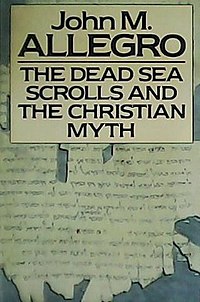The Dead Sea Scrolls and the Christian Myth
 First edition | |
| Author | John M. Allegro |
|---|---|
| Language | English |
| Subject | Language, Fertility cults, Christianity, Dead Sea Scrolls |
| Publisher | West bridge Books (a division of David & Charles) |
Publication date | 1979 |
| Publication place | United Kingdom |
| Media type | print (paperback) |
| Pages | 252 (second revised edition) |
| ISBN | 978-0-879-75757-1 |
The Dead Sea Scrolls and the Christian myth is a 1979 book about the Dead Sea Scrolls, Essenes and early Christianity that proposes the non-existence of Jesus Christ. It was written by John Marco Allegro (1922–1988).[1][2][3][4][5][6][7]
Content
[edit]The book was written nine years after Allegro's forced resignation from academia due to publishing The Sacred Mushroom and the Cross. It is an imaginative look at what life would have been like at Qumran, Judea at the time when Jesus was supposed to have lived in the 1st century CE.[8]
The book's aim was to show the logical progression of Jewish history through the writings and archaeology of Qumran, as opposed to the (unique) revelation of traditional Christianity.[9] Allegro suggested that traditional Christianity developed through a literal misinterpretation of symbolic narratives found in the scrolls by writers who did not understand the minds of the Essenes. He further argued that Gnostic Christianity developed directly from the Essenes and that Jesus Christ was a fictional character based on a real person, who had helped establish the Essene movement (or "Way") and lived in the 1st century BCE, around one hundred years before the traditional period of New Testament events.[1] In a chapter entitled "Will the real Jesus Christ please stand up," Allegro referred to this man as the Teacher of Righteousness.[3][7]
Allegro argued that the word Essenes signified "healers" and that the Essenes had inherited a lore of healing with plants and stones that had been passed down from the "fallen angels" that arrived on Mount Hermon mentioned in the Book of Enoch. He presumed their establishment of Qumran complex by the Dead Sea was related to the interpretation and anticipation of a prophecy about the Teacher of Righteousness, a "man whose appearance was like the appearance of bronze, with a line of flax and a measuring rod in his hand," (Ezekiel 40:3) who was to somehow create lifegiving waters to flow into the Dead Sea from a temple in some northern location (Ezekiel 47:1–12).[2]
Reaction
[edit]The book received widespread criticism from the academic community: numerous rebuttals were published,[10] and other members of the team pointed out the problems with Allegro's arguments.[9] Randall Price called Allegro "the father of scroll sensationalists" for his interpretations of the scrolls.[11] Allegro believed that there was a conspiracy to prevent publication of the scrolls because they could damage the image of Jesus, which was later repeated by conspiracy theory writers such as Richard Leigh and Michael Baigent in their book The Dead Sea Scrolls Deception.[1]
Allegro's theories about the relationship of the scrolls to Jesus were widely rejected and led to his rapid downfall.[1] Allegro had previously published The Sacred Mushroom and the Cross in 1970, with even more theories[clarification needed] about Jesus. Allegro was heavily criticized by many scholars, including his own mentor at Oxford, and his publisher issued an apology.[1] Allegro's scholarly reputation was destroyed, and he had to resign from his academic position.[1]
See also
[edit]References
[edit]- ^ a b c d e f Peter Flint; James VanderKam (10 July 2005). The Meaning of the Dead Sea Scrolls: Their Significance For Understanding the Bible, Judaism, Jesus, and Christianity. Continuum International Publishing Group. pp. 324–. ISBN 978-0-567-08468-2. Retrieved 4 November 2012.
- ^ a b Joan E. Taylor (2012). The Essenes, the Scrolls, and the Dead Sea. Oxford University Press. pp. 305–. ISBN 978-0-19-955448-5. Retrieved 4 November 2012.
- ^ a b John Marco Allegro (1992). The Dead Sea Scrolls and the Christian myth. Prometheus Books. ISBN 978-0-87975-757-1. Retrieved 4 November 2012.
- ^ "Controversy Over Scrolls on in Print", Deseret News (Salt Lake City, UT) – November 21, 1992.
- ^ Todd, Douglas, Turning the spotlight on Jesus of Nazareth Greed, scandal, mystery surround Dead Sea Scrolls, Waterloo Record – Kitchener, Ontario, (Weekend Edition), 7 March 1992.
- ^ 'Enhanced Interrogation' and Faith, Scariato, Albert., The Washington Post, May 28, 2009.
- ^ a b Judith Anne Brown (2005). John Marco Allegro: The Maverick Of The Dead Sea Scrolls. Wm. B. Eerdmans Publishing. pp. 265–. ISBN 978-0-8028-2849-1. Retrieved 4 November 2012.
- ^ Mary L. Coloe; Tom Thatcher (2011). John, Qumran, and the Dead Sea Scrolls: Sixty Years of Discovery and Debate. Society of Biblical Lit. pp. 19–. ISBN 978-1-58983-546-7. Retrieved 6 November 2012.
- ^ a b Lawrence H. Schiffman (2010). Qumran and Jerusalem: Studies in the Dead Sea Scrolls and the History of Judaism. Wm. B. Eerdmans Publishing. pp. 414–. ISBN 978-0-8028-4976-2. Retrieved 6 November 2012.
- ^ Joseph M. Baumgarten; Moshe J. Bernstein; Florentino García Martínez; John Kampen (1997). Legal Texts and Legal Issues: Proceedings of the Second Meeting of the International Organization for Qumran Studies, Cambridge, 1995 : Published in Honour of Joseph M. Baumgarten. Brill. pp. 19–. ISBN 978-90-04-10829-5. Retrieved 6 November 2012.
- ^ Randall Price (1996). Secrets of the Dead Sea Scrolls. Harvest House Publishers. pp. 360–. ISBN 978-1-56507-454-5. Retrieved 6 November 2012.
